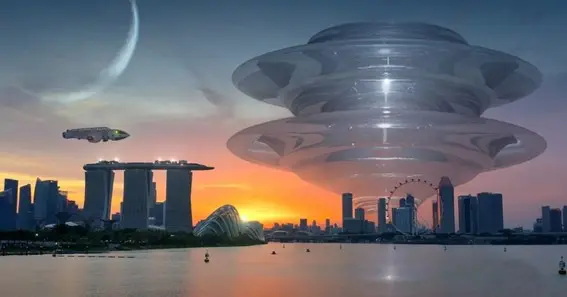Science fiction (sci-fi) has long served as a fertile ground for envisioning architectural marvels that challenge conventional design paradigms. From towering megastructures to intricate space habitats, sci-fi architecture not only fuels our imagination but also influences real-world architectural practices.
The Essence of Sci-Fi Architecture
At its core, sci-fi architecture embodies visionary designs that often transcend current technological and material limitations. These imaginative constructs serve as a canvas to explore possibilities, question norms, and address future societal needs. Architectural imagination is undoubtedly an inevitable part of science fiction, with authors crafting intricate descriptions of spaces to build vivid images in the minds of readers.
Also Read N: Elevate Your Game: Nike Kids’ Mercurial Zoom Superfly 9 Pro FG Soccer Cleats
Iconic Examples in Science Fiction Media
- The Walking City by Ron Herron (1964): This concept envisions mobile, self-contained urban structures that traverse landscapes, reflecting adaptability and resilience.
- Plug-In City by Peter Cook (1966): A theoretical megastructure allowing modular residential units to be added or removed, emphasizing flexibility in urban planning.
- Blade Runner’s Los Angeles (1982): The film showcases a dystopian cityscape with towering skyscrapers and neon-lit streets, influencing cyberpunk aesthetics in architecture.
Also Read P: Nike Premier III FG: Classic Craftsmanship Meets Modern Performance
Real-World Architectural Inspirations
The boundary between sci-fi and actual architecture is increasingly blurred, with several contemporary designs drawing direct inspiration from science fiction:
- Chengdu Science Fiction Museum: Designed by Zaha Hadid Architects, this under-construction venue is set to host the 81st World Science Fiction Convention, embodying futuristic design principles.
- Pearling Path Visitors Center in Bahrain: Architect Valerio Olgiati’s design features a monumental structure with a futuristic aesthetic, blending traditional cultural elements with modern design.
- Steampunk-Inspired Designs: The steampunk genre merges historical technology with fictional elements, influencing architectural designs that blend vintage mechanical aesthetics with modern functionality.
The Impact on Urban Planning and Sustainability
Sci-fi architecture often presents utopian or dystopian visions of urban environments, prompting reflection on sustainability and livability. Concepts such as vertical gardens, self-sustaining habitats, and smart cities depicted in science fiction are increasingly explored in contemporary urban planning to address challenges like overpopulation and resource scarcity.
Conclusion
Science fiction continues to be a catalyst for architectural innovation, inspiring designs that push the boundaries of creativity and functionality. As technological advancements unfold, the once-imaginary structures of sci-fi may become integral components of our built environment, reflecting our aspirations and addressing future societal needs.
FAQ
1. How does science fiction influence modern architecture?
Science fiction inspires architects to explore unconventional designs and innovative solutions, often addressing futuristic themes and societal challenges.
2. Can you provide examples of real buildings inspired by sci-fi concepts?
Yes, the Chengdu Science Fiction Museum by Zaha Hadid Architects and the Pearling Path Visitors Center in Bahrain by Valerio Olgiati are notable examples.
3. What is the significance of Archigram in sci-fi architecture?
Archigram was an avant-garde architectural group in the 1960s known for futuristic concepts like the Walking City and Plug-In City, which have influenced modern architectural thinking.
4. How does sci-fi architecture address sustainability?
Sci-fi architecture often envisions self-sustaining habitats and eco-friendly designs, prompting real-world exploration of sustainable urban planning solutions.
5. Are there any architectural competitions focusing on sci-fi designs?
Yes, competitions like the Fairy Tales showcase encourage architects to create visionary designs inspired by science fiction narratives.










